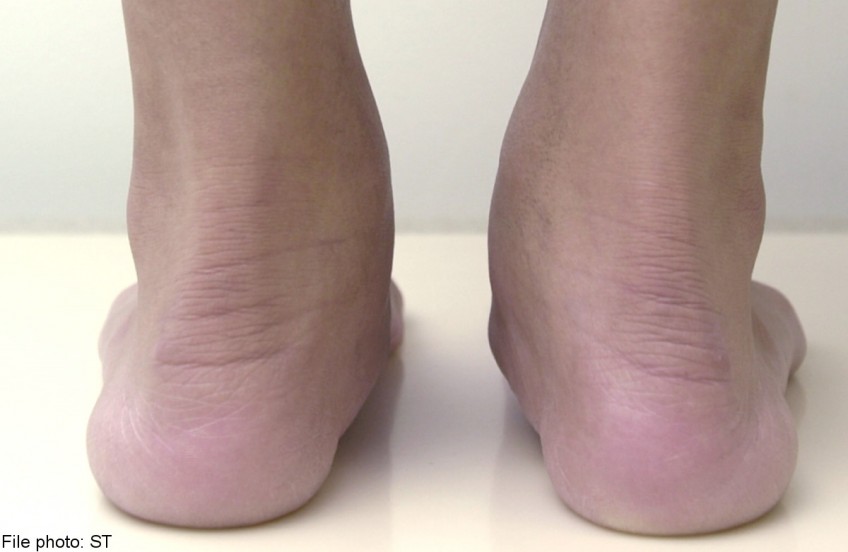What's the cause of the ache at the back of my ankle?


Q. I am a 45-year-old man. I have this tight muscle or aching feeling at the back of my ankle.
The feeling of tightness comes and goes but there is no serious pain. I have gone for a foot massage several times but the tightness persists.
I run on the treadmill and on the road about two to three times a week for about 40 minutes each time. There is no pain when I run.
Do I have a medical condition and should I seek the help of a doctor or traditional Chinese medicine practitioner?
A. There are a few conditions associated with muscle tightness or aching at the back of the ankle.
Some common conditions include calf tightness, Achilles tendinopathy and referred pain from neural structures or the lumbar spine.
The calf muscles comprise the gastrocnemius and soleus muscles, which primarily help to lift up the heel and support the ankle.
Calf tightness is a common condition in runners and may have developed over a period of time as the calf muscles gradually tighten with regular running or from a previous calf strain.
The calf muscles usually remain tight unless they are stretched, which is why symptoms of muscle tightness may occur. This can be resolved with exercises to stretch the muscles.
Sudden overload
The Achilles tendon is where the calf muscles attach to at the calcaneum (heel bone).
Achilles tendinopathy refers to an overuse of the Achilles tendon, which may involve pain, swelling and impaired performance.
Changes in various factors during training may have adverse effects on the load on the tendon.
If you go from being sedentary to running 5km every day, a sudden overload may occur. On the other hand, stopping your running routine abruptly may cause an underload. This may result in micro-trauma in the tendon.
Adequate rest is necessary to allow the tendon to heal.
If it does not heal completely, the damage may build up, resulting in a weakened tendon less capable of withstanding loads.
This may manifest as symptoms of tightness, aching or pain at the back of the ankle, which comes about either with prolonged training or at an early stage of training.
This condition would require careful management. First, adequate rest is needed so the injured tendon can recover. Subsequently, properly timed exercises to strengthen the Achilles tendon and calf muscles may be needed before one can return to one's regular running routine.
Meanwhile, the nerves which exit the spine at the lower back region are linked to the lower limbs.
Injuries to the lower back structures, such as the muscles, discs, nerves or joints, may refer pain down to the back of the ankle.
This may trigger pain, aches or altered sensations such as pins and needles or numbness.
If the nerve is compromised, symptoms such as muscle weakness may occur.
This condition may require further management with medication, exercises, manual therapy and further diagnostic imaging.
Training factors
There are various training factors which can contribute to the above conditions, such as a change in footwear, which may alter the biomechanics of running and change the load on the Achilles tendon, calf muscles or lower back.
An increase in the intensity, duration and frequency of training - for example, changes in the distance, speed or gradient of the training ground - can also contribute to muscle tightness.
Other factors are one's recovery time between training sessions and a change of running surface.
Previous injuries may have caused weaknesses in the calf muscles, poor muscle flexibility or restricted joint range. These can increase the strain on a person's back and calf muscles or the Achilles tendon.
Failing to use the muscles in the body efficiently to optimise running capacity and an excessive pronation of the foot can also increase the load on the calf muscles.
From your description of your symptoms and activities, it appears that you have a case of calf tightness or Achilles tendinopathy.
Having foot massages may not have been effective in resolving the tightness or aches.
It would be advisable to see a doctor who would be able to rule out any other conditions and advise you on the appropriate care needed.
It would be best to identify the condition for early treatment, which may include rest, exercises to increase muscle flexibility, correction of the predisposing factors, strengthening of the muscles around the foot and ankle and a graduated programme to return to running.
MS CHERYL POON
Physiotherapist at Singapore General Hospital

Get a copy of Mind Your Body, The Straits Times or go to straitstimes.com for more stories.